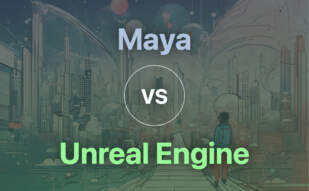Houdini is a renowned 3D animation and VFX software developed by SideFX, catering to film, TV, and game industries with its node-based workflow and dynamic simulation tools.

For those on the lookout for options beyond Houdini, alternatives encompass Maya, Cinema 4D, 3ds Max, Blender, Unity, Unreal Engine, ZBrush, TouchDesigner, After Effects, Max MSP, Resolume, Unreal Engine 5, Element 3D, Notch, Jitter, KeyShot.
Maya
Meeting you at the intersection of innovation and creativity is Maya. Revolutionizing how we approach 3D computer graphics, Maya, or Autodesk Maya, is a tour de force in the realm of animation assets and visual effects. With roots dating back to 1998, Maya holds a venerable reputation for its highly customizable user interface and extensive functionalities.
Maya Top Features
- Integrated renderer, mental ray: Known for advanced features like global illumination, subsurface scattering.
- Comprehensive functionalities: Ranging from 2D drawing and 3D modeling to data import/export and animation simulation.
- Powerful animation capabilities: Allows advanced movement, deformations, and effects, ideal for creating believable, interactive 3D animations.
- NURBS modeling system: Perfect for crafting complex, highly detailed shapes.
| Feature | Benefit |
| Detailed Texturing and Shading | Enhances the quality and realism of final render. |
| Advanced Rigging System | Provides superior control over character and object manipulations. |
| Import Capabilities to Game Engines | Easy transition of assets to engines like Unreal Engine and Unity. |
Maya Limitations
- High learning curve: Due to Maya’s complexity and wide range of tools, mastering it can be challenging for beginners.
- Cost: Monthly and yearly subscription fees could be a deterrent for smaller businesses.
Maya Pricing
Maya steps up with pricing options to suit diverse needs. Ranging from monthly to yearly subscriptions, affordability is in the eye of the beholder. For businesses earning less than $100,000, a reduced fee applies. A free trial is available for those who would like to test the waters, and did we mention the special educational license?
Maya Use Cases
Use case 1: Film Industry
With an impressive showreel including films such as The Lord of the Rings series, Ice Age, Star Wars series, Maya makes a splash to create memorable cinematic experiences.
Use case 2: Animation Industry
Maya’s open architecture and outstanding animation capabilities ensure a seamless workflow for producing high-quality animated films and TV series.
Use case 3: Businesses and Educational Institutions
Lower fees for smaller businesses and an educational license allow for expansive usage in various industrial applications and imparting knowledge in academic institutions.
Cinema 4D
Presenting Cinema 4D, an extraordinary 3D modeling software with a proficiency in motion graphics, enabling the creation of photorealistic materials, animations, characters, and creatures.
Cinema 4D Top Features
- Accessible hierarchical list for efficient object management.
- Geometry objects can be manipulated directly in the viewport.
- Extensive tools for polygonal modeling, volume modeling, and sculpting.
- Dynamic animation capabilities allowing any object, material, or parameter to be animated.
- Powerful scene nodes, encapsulating objects and operations.
- State-of-the-art ZRemesher tech integration from Pixologic’s ZBrush.
- Unified simulation system, for generating dynamic effects like cloth, soft bodies, and rope.
| Feature | Benefit |
|---|---|
| Redshift 3D | A GPU renderer which is artist-friendly and enables quick iteration. Redshift in CPU mode is also available. |
| Poly Pen | A bespoke tool for specific design needs. |
| S26 and 2023 releases | Introducing significant improvements such as fit circle, straighten edges, and flatten components. |
Cinema 4D Limitations
- Price could be a barrier for some, with the perpetual license cost marked at $3,495.
- Lack of certain advanced features found in competing software.
Cinema 4D Pricing
Acquiring Cinema 4D hits multiple price points: Monthly subscription at $94, annual at $719, and the perpetual license at $3,495. Take note, educational access is available at $9.99 for 6 months.
Cinema 4D Use Cases
Use case 1: Motion Graphics
With its prowess in motion graphics, Cinema 4D is an excellent tool for creating distinctive animations and interactive content.
Use case 2: Character Design
Cinema 4D’s character and creature creation tools enable artists to bring unique personas to life.
Use case 3: Architechtural Visualization
With its strong photorealistic material generation, Cinema 4D is beneficial for architectural visualization projects.
Resolume
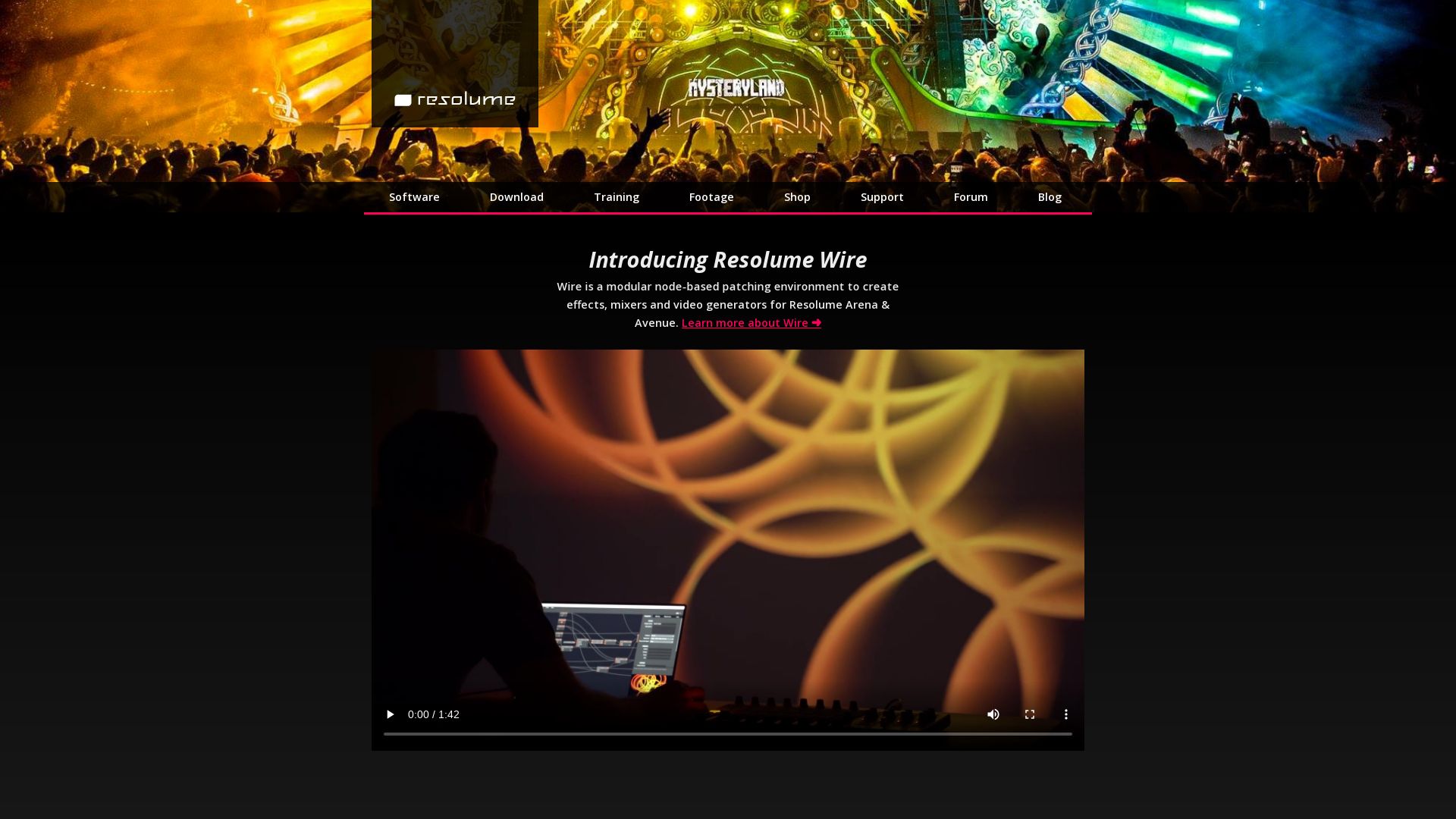
A pioneer in the realm of video music and audiovisual live, Resolume represents a cutting-edge tool for digital artists. From DJing to VJing, it amalgamates multiple forms of art like directing, music production, and sound designing under one robust platform, thus shaping an eco-innovative approach.
Resolume Best Features
- Projection Mapping: Resolume ARENA 7 is explicitly designed for projection mapping, allowing projections on any surfaces.
- Edge Blending & DMX Fixtures: It supports edge blending for seamless projection with multiple projectors, and DMX fixtures for sync lights.
- Real-time Rendering & Live Composite: These ensure adjustable clip scale and position with real-time effects.
- Integration with Other Apps: Resolume offers compatibility with other apps via Syphon (Mac) or Spout (Windows)
- Control Options: MIDI controllers or iPhone can control Resolume outputs via OSC. It also has native support for Blackmagic, AJA and Datapath capture cards.
| Feature | Description |
|---|---|
| Visual Effects Plugins | Resolume’s visual effects are plugins, with capacity for additional 3rd party plugins |
| DMX Lighting Desk Integration | Able to be controlled from a lighting desk, integrating tech with physical controls. |
| Remix Creation | Enables remixing by sampling, cutting and pasting elements forming new context similar to electronic music using samples. |
Resolume Downsides
- Copyright Issues: Often, copyright can impede the creation of remixes.
- Specific Software Knowledge: Being a feature-rich tool, it may require specific software knowledge to leverage all its resources.
Resolume Pricing
While the pricing details for Resolume are not provided explicitly, it’s recommended to check the official website for the most current and accurate information. The balance between cost and ecological footprint must always be kept in mind while opting for digital solutions.
Resolume Use Cases
Use case 1: AV performers
Resolume serves as a comprehensive platform for AV performers who seek to integrate DJing, VJing, directing, and sound designing, thus minimizing their digital footprint.
Use case 2: Projection Mapping
For projection artists, Resolume ARENA 7 supports various forms of projection including complex geometrical structures and buildings – making it a versatile, green choice.
Use case 3: Entertainment Industry Professionals
Its real-time rendering and live composite features play a crucial role in the entertainment industry, enabling professionals to create innovative yet sustainable content.
Unreal Engine 5
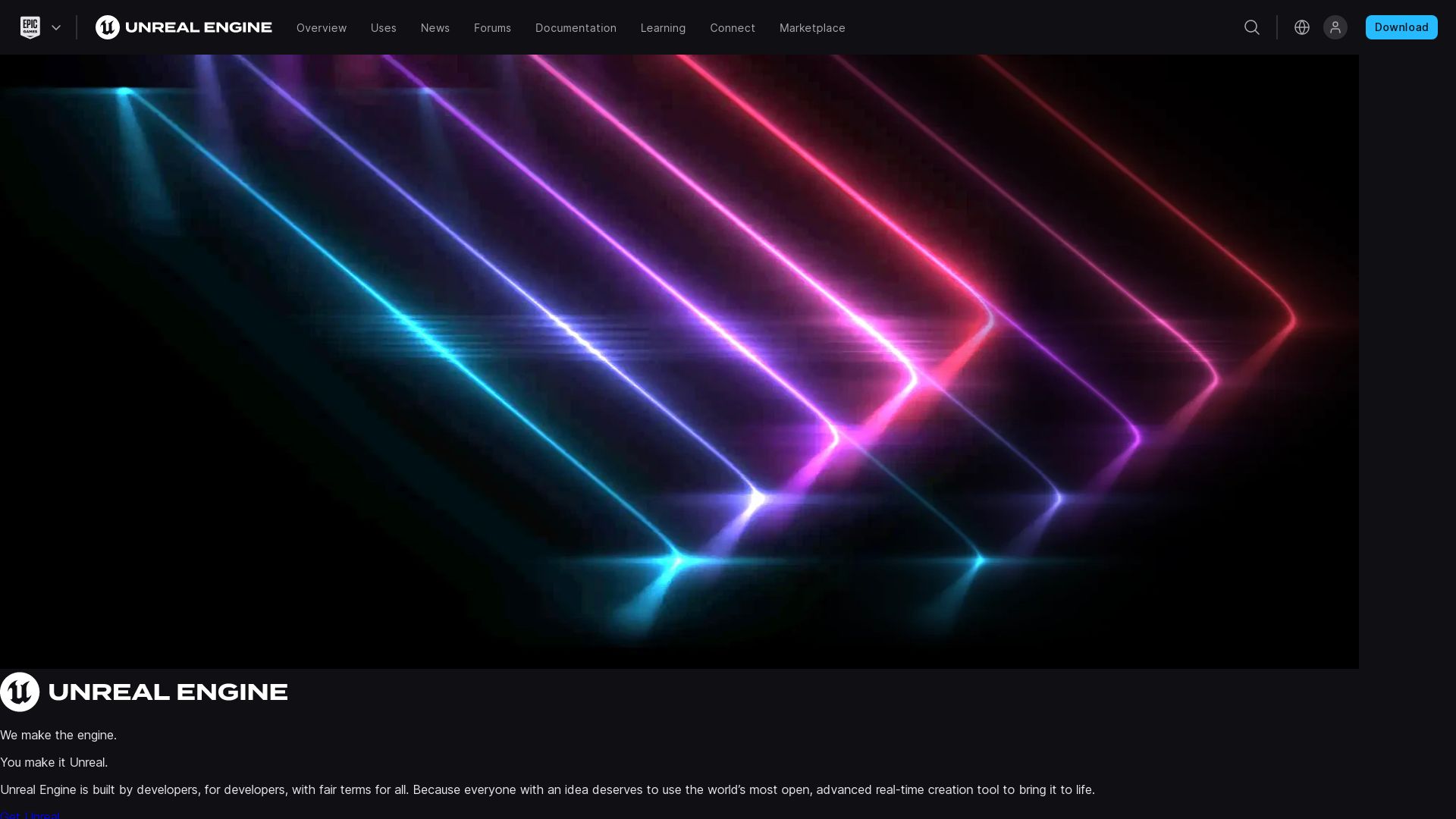
Developed by Epic Games, Unreal Engine 5 is a revolutionary tool for next-gen real-time 3D content creation, boasting sublime features such as Nanite, Lumen, and Control Rig that redefine the boundaries of design realism.
Unreal Engine 5 Top Features
- Nanite: Enables creation of detailed worlds, processing multi-million-polygon meshes at real-time frame rates.
- Lumen: Provides fully dynamic global illumination and reflections, adjusting instantly to changes in lighting or geometry.
- Temporal Super Resolution (TSR): Upsamples low-res rendering with high-res pixel fidelity, enhancing 60 fps performance.
- World Partition: Segmentizes the world into grids, streaming essential cells for efficient team collaboration.
- Control Rig: An integrated animation authoring toolset to expedite the creation process.
| Feature | Explanation |
|---|---|
| Nanite | Allows immense detail in world creation by processing multi-million polygon meshes in real-time. |
| Lumen | Offers dynamic global illumination and reflections that adapt instantly to lighting or geometry changes. |
| Control Rig | An inbuilt animation authoring toolset that cuts down on back-and-forth in the creation process. |
Unreal Engine 5 Limitations
- Dependency on royalties: Epic Games waives the 5% gross revenue fee for games published on their store, but for others, once lifetime gross exceeds $1 million, the fee applies.
- Development Cost: Depending on the scale of the project, the cost of development may range from $35K to $85K.
Unreal Engine 5 Pricing
While UE5 offers a wealth of free sample projects, beware of its royalty model. Although Epic charges no upfront cost, a royalty fee of 5% kicks in once your game’s lifetime gross surpasses $1 million. However, if you publish on the Epic Games Store, this royalty fee is waived.
Unreal Engine 5 Use Cases
Use case 1: Develop High-Fidelity Games
UE5 can handle enormous and highly detailed worlds, thanks to its Nanite technology. Further aided by TSR, it ensures top-quality graphics without compromising performance.
Use case 2: Real-Time Cinematic Productions
Lumen’s global illumination capabilities make UE5 ideal for real-time cinematic productions, where lighting plays a key role in setting the mood and tone.
Use case 3: Collaborative Environment Design
The World Partition feature facilitates team members to work concurrently on different sections of the same world, making UE5 an excellent tool for large collaborative projects.
Element 3D
Immerse yourself in the world of Element 3D, an exceedingly high-performance After Effects plug-in designed meticulously for the creation of motion design and visual effects. Seamlessly importing 3D objects and textures (OBJ & C4D formats), Element 3D serves as the quintessential tool for breathing life into your creation.
Element 3D Top Features
- Impressive 3D Shadows Support: Embraces a diversity of shadows support, encompassing OpenGL shadows (for faster results), improved SSAO (for enhanced speed), as well as ray trace shadows & AO (for slower, yet meticulous results) and ray-traced AO.
- Sublime Interface Redesign: With group folders, new texture, Levels control, and new parametric objects, the interface has been upgraded for seamless navigation.
- Dynamic Reflection Maps: Offering a unique facet to portray object reflections vividly.
| Features | Details |
|---|---|
| 3D File Formats | Supports OBJ, C4D (R12-R20). |
| Compatibility | Compatible with After Effects CS5, Windows 7 SP1, Mac 10.8.5, and up. |
| Graphic Card Requirements | Requires 1GB of VRAM, supports NVidia and ATI. |
Element 3D Downsides
- Computer Resource Intensive: May tend to bear down heavily on your system resources.
- Necessity of Graphic Card: Requires a substantial graphic card (1GB of VRAM) to execute efficiently.
Element 3D Use Cases
Use Case 1: Motion Designers
Vital for the toolkit of motion designers, Element 3D offers unparalleled ease to create captivating motion designs that truly embody their vision.
Use Case 2: Visual FX Artists
For visual FX artists, Element 3D proposes a universe of unlimited potential, brewing the capacity to craft extraordinary visual effects.
Use Case 3: 3D Artists
When it comes to 3D artists, Element 3D signifies a robust platform for importing and manipulating 3D models, paving the way for unforeseen aesthetic realizations in their craft.
Notch

Aiming to revolutionize real-time visual effects, Notch offers innovative solutions utilized globally by artists, brands, and live events. Originating from the UK, it provides an all-in-one platform where individuals can create, simulate, commiserate, play, and more. With environmental consciousness at the base of every digital development, let’s delve into what Notch brings to the green-tech table.
Notch Top Features
- Interactive and generative content: User-friendly interfaces promote the creation of intuitive and immersive user experiences.
- Real-time effects and filters: These significantly enhance the aesthetics of any project, reducing the need for post-processing and thereby decreasing energy consumption in production.
- 3D graphics creation and VR experiences: Progressing further towards sustainability, they allow for higher-end visualizations with minimum physical resources utilization.
- Unified Environment: Combines multiple features such as rendering, compositing, and editing in one place, improving efficiency and reducing digital clutter.
| Media Server Blocks | Enable easy pre-show changes without the need for time-consuming, energy-wasting re-rendering. |
| Output Options | Flexibly export your project as video files, media server blocks, or applications as required. |
Notch Limitations
- Limited to a rental service, there is no option for outright purchase. This might not be ideal for all customers.
- While it has a vast array of features, it can seem complex for beginners in digital graphics. They face a slightly steep learning curve.
- There’s a significant jump in price between the base and professional editions, potentially deterring smaller businesses or individual users.
Notch Pricing
A subscription service, Notch offers a free version with limited tools, while the Base Edition is priced at $130/month, and the Professional version is $249/month.
Notch Use Cases
Use Case 1: Live Events and Music
Notch serves as an invaluable tool for live event creators and musicians, allowing them to swiftly change visual effects without requiring tedious re-rendering, saving both time and energy.
Use Case 2: Motion Graphics
Given its node-based application and customizable interfaces, Notch proves to be a robust tool for motion graphics, presenting infinite creative potential while preserving resource efficiency.
Use Case 3: Interactive and Immersive Experiences
Notch excels in creating interactive and immersive experiences, seamlessly integrating with MIDI, video, and motion capture data sources. This invites endless opportunities for innovation in virtual spaces, supporting our transition towards a more sustainable digital future.
Jitter
Developed by the San Francisco-based company, Cycling ’74, Jitter is a visual programming language notably used for music and multimedia. It is highly favored by performers, composers, artists, software designers, and researchers to create performances, recordings, and installations in real time.
Top Features of Jitter
- Real-Time Sound Synthesis: Jitter stands out for its real-time audio and video synthesis and processing.
- Modular: Most routines of Jitter are in shared libraries, making it highly modular.
- Third-Party Development: Jitter supports the development of new routines (external objects) by third parties.
- Interface: Its interface is notably robust, being a bridge between real-time playback and stored digital data.
| HDMI jitter reduction: | Jitter has proven to consistently reduce HDMI jitter without dependence on interface. |
| Audibility: | Tests and measurements have shown Jitter to eliminate interface jitter below audibility level. |
| Data Types: | Recognized for operations with six basic atomic data types: int, float, list, symbol, bang, and signal (for MSP audio connections). |
Limitations of Jitter
- Limited appeal to non-audio professionals.
- Complexity for beginners who lack knowledge of audio synthesis and processing.
Jitter Pricing
N/A
Jitter Use Cases
Use Case 1: Real-time Sound Synthesis
For user groups like performers and composers, Jitter provides impactful real-time sound synthesis. This capability allows for immediate manipulation of digital audio signals crucial in the creation of performances and compositions.
Use Case 2: Audio Research
Researchers who study audio patterns and systems find Jitter’s interface and data handling capabilities relevant in their field. This broadens the applicability of Jitter to a more academic context.
Use Case 3: Multimedia Installations
Another important use case is for artists specializing in multimedia installations. The modular nature and third-party development support of Jitter create an adaptable platform where artists can customize their audio-visual projects.
KeyShot
Meet KeyShot, a globally recognized company providing top-notch 3D rendering tools to gear up your design visualization, collaboration, and publishing.
KeyShot Top Features
- An intuitive interface that focuses more on design, allowing an easier transition from CPU to GPU mode.
- Real-time updates to display changes in material, lighting, and geometry.
- An extensive library of plugins for updating geometry without loss of work.
- The 3D Paint functionality added in KeyShot 2023 for customizing material and finish by painting or stamping on the model surface.
- A Physics Simulation tool for recording physics of objects and apply them as keyframe animation.
- Native support for Apple silicon for enhanced performance and usability.
- Render layers using the EXR option.
| 3D Rendering Solutions | Provides company-wide 3D rendering solutions to promote collaboration and provide visualization. |
| New Features KeyShot 2023 | Includes features to improve workflow, color, materials, collaboration and more. |
| Material Library | Available material library including Gloss values, Cie-Lab colors and brand-name libraries like Pantone and RAL. |
| Web Viewer Optimisation | KeyShot 2023’s Web Viewer optimized for high-quality visuals on web and mobile browsers. |
KeyShot Limitations
- Limited in advanced input and output control, simulations, advanced animations, and hair/fur generation with grooming.
KeyShot Use Cases
Use case 1: Product Design
From idea conception to rapid prototyping, KeyShot is an essential tool in product design processing.
Use case 2: Engineering Visualization
Complex ideas become understandable for engineers with KeyShot’s realistic 3D rendering tools.
Use case 3: Marketing Visualization
KeyShot is a boon for marketing teams as visuals can be generated without waiting for product photography.
3ds Max
Standing as a staple of 3D graphics and modeling, 3ds Max is a feature-rich offering by Autodesk Media & Entertainment. Originally known as 3D Studio, it has left an indelible impression on areas like 3D animations, models, games, and images.
3ds Max Top Features
- Robust Modeling Capabilities: Offers both Polygon modeling and Non-Uniform Rational Based-Splines (NURBS) for smooth sphere creation.
- Flexible Plugin Architecture: Allows for unique customization and extension of the base software.
- Scene Explorer: Provides a hierarchical view of all the components in a scene.
- MAXScript: A built-in scripting language for automated or customized operations.
- Integrated Cloth Solver: Allows realistic cloth simulations within the software.
| Feature | Benefit |
|---|---|
| Keyframing | Supports two unique modes for precision animation controls. |
| Integration with Autodesk Vault | Consolidates 3ds Max assets for easier management within the software. |
3ds Max Limitations
- Exclusive to Windows platform, lacking versatility for Mac users.
- Complex user interface may have steep learning curve for newcomers.
- Pricing operates on a pay-as-you-go tokens basis, potentially costly for heavy users.
3ds Max Use Cases
Use case 1: Video Game Development
3ds Max boasts wide usage amongst video game developers, thanks to its excellent polygon modeling capacity and plugin flexibility. It’s instrumental in creating immersive game worlds and assets.
Use case 2: Movies and Special Effects
Creating pre-rendered scenes and special effects for movies is another strong suit of 3ds Max. Its robust toolset, from MAXScript to cloth simulations, serve as the foundation for jaw-dropping cinematic visuals.
Use case 3: Architectural Presentations
3ds Max finds a place in architectural design firms, helping modelers craft detailed, lifelike presentations. Its support for .dwg files and Autodesk Vault integration facilitates smoother project workflows.
Blender
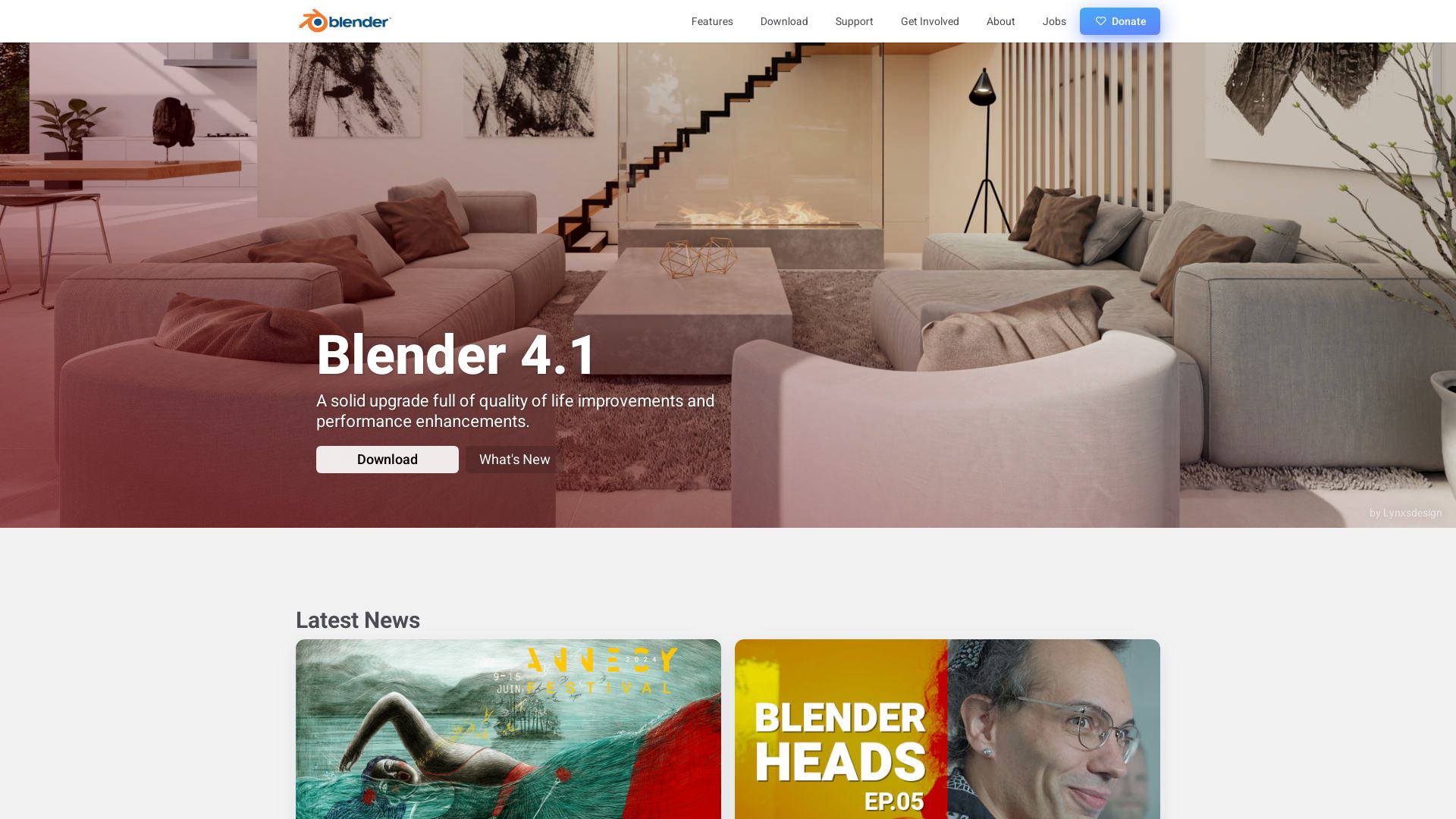
Developed in 1994 by the Dutch animation studio NeoGeo and publicly released in 1998, Blender is a free and open-source 3D computer graphics software tool set. From animated films to virtual reality, its versatility is vast.
Blender Top Features
- 3D Modelling: Blender offers comprehensive tools to create, transform and edit your 3D models.
- UV Mapping and Texturing: Map your 2D textures onto your 3D models with precision.
- Digital Drawing and Raster Graphics Editing: Blender’s interfaces enable you to create and edit 2D sprites or graphics.
- Sculpting and Animation: Create lifelike characters and worlds with Blender’s sculpting and animation tools.
| Feature | Description |
|---|---|
| Particle Simulation | Create complex physical effects, from realistic smoke to dazzling explosions. |
| Rendering | Blender’s Eevee renderer provides high-quality light and shadow effects. |
| Video Editing | Assembling your final 3D footage is made easy with its supplied video editor. |
Blender Limitations
- Steep Learning Curve: Blender, in all of its complexity, is not beginner-friendly and requires substantial learning.
- Game Engine Depreciation: The Blender Game Engine was deprecated in the 2.8 release, which may affect developers specifically looking for this feature.
- Internal Renderer Removal: The Blender Internal was removed in the 2.80 release, moving entirely to the Eevee renderer which may cause compatibility issues with older projects.
Blender Pricing
Asa benevolent entity, Blender is entirely free for all users across Linux, macOS, Windows, BSD, and Haiku platforms.
Blender Use Cases
Use case 1 – Animated Films
Blender’s complete suite of modelling, animation, and rendering tools provide an all-in-one solution for creating animated films, perfect for studios or individual artists.
Use case 2 – Visual Effects
With advanced simulation tools, artists can create stunning visual effects for videos and films. Blender also supports a myriad of 3D file formats for seamless integration.
Use case 3 – 3D-Printed Models
Engineers and designers can leverage Blender’s precise modelling and texturing capabilities to create accurate 3D printed models.
Unity

Introducing Unity, a game development titan launched in 2005, offering an impressive engine for creating 3D and 2D games. It’s built for cross-platform launches, embracing everything from Android and iOS, to a pool of different operating systems. Unity’s realm isn’t just limited to game creation; Think beyond – Augmented Reality to 3D simulations.
Unity Best Features
- Dedicated rendering technology and a comprehensive tool suite that foster high-quality game creation.
- A massive asset store with diverse pre-designed textures and features to inspire fresh game designs.
- Flaunts compatibility with multiple coding languages, including BOO script, Javascript, and C#.
- An active developer community which encourages engagement, problem solving and feedback for system enhancement.
- Continuous tech evolution to uplift user-friendliness, compatibility, and immersive visual experiences.
| Noteworthy Features | Description |
|---|---|
| Asset Library | An Encyclopaedia of pre-designed textures and features that breathe life into game designs. |
| Evolution Oriented | Unity evolves with the times, pushing tech boundaries for elevated compatibility and immersive experiences. |
Unity Downsides
- The new pricing model is causing ripples of unrest, especially among indie and mobile developers.
- Unannounced changes have led to a loss of trust between Unity and its users.
- Fears of sudden pricing shifts threatening the financial stability of developers.
Unity Pricing
The pricing structure includes a fee each time a game that uses Unity software is installed. A new pricing model will be in effect beginning January 1, 2024. However, developers are assured that they will not be charged an install fee until their game generates $200,000 in revenue and achieves more than 200,000 installations.
Unity Use Cases
Use case 1
Unity combines powerful tools and technology, making it an appealing choice for creators focusing on 3D or 2D game development across multiple platforms.
Use case 2
With its vast asset store and coding language compatibility, Unity opens a paradise for developers keen on experimenting with various game designs and languages.
Use case 3
Unity harnesses Augmented Reality (AR) and Virtual Reality (VR) capabilities, making it suitable for projects that require immersive elements and advanced visual experiences.
Unreal Engine
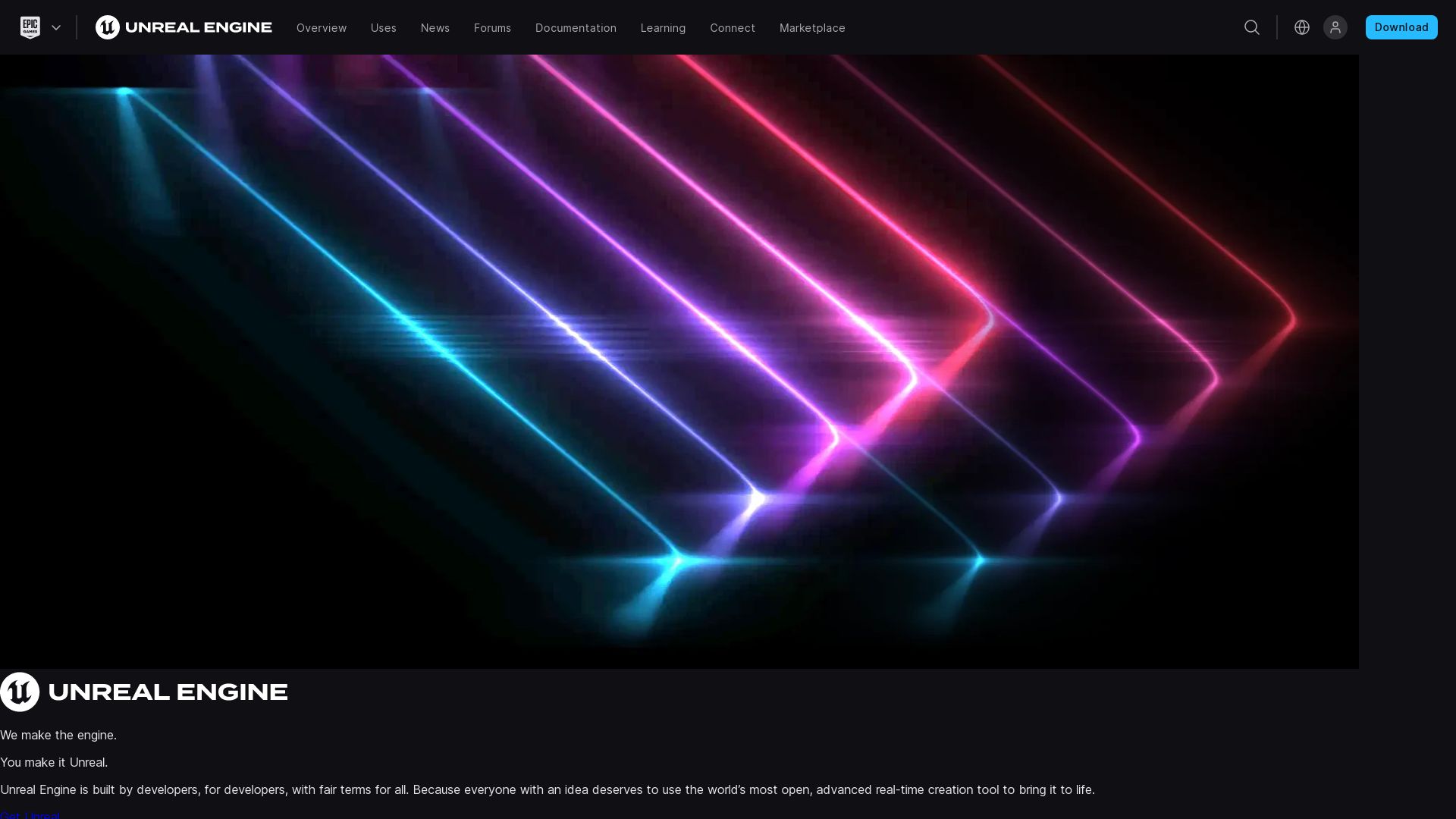
Meet Unreal Engine, a powerhouse in the galaxy of 3D computer graphics game engines. Developed by Epic Games, it has been transforming the game development landscape since its debut in 1998 with the PC first-person shooter game, Unreal. But Unreal Engine’s magic isn’t confined to gaming. It’s also a sought-after tool in industries like film and television.
Unreal Engine Top Features
- Beyond gaming: Unreal Engine transcends the gaming world, dabbling in film and television industries too.
- Platform diversity: Whether it’s desktop, mobile, console or VR platforms, Unreal Engine has you covered.
- Language of the masses: Written in C++, it’s a language most developers are familiar with.
- Open to all: Unreal Engine 3 provided a welcoming environment for modders, sparking creativity.
- Marketplace magic: Unreal Engine Marketplace, where up-and-coming developers can hawk their creations and even snag an impressive 88% share of the revenue that’s generated! Unbridled exchange of innovation, anyone?
| UnrealEd | A constructive solid geometry-operation-supporting level editor that’s part of Unreal Engine. |
| Basic Project Templates | Unreal Engine provides easy-to-use starting points for a first-person or third-person experience. |
| Global Aspirations | With strategic allies, Epic Games aims to popularize its software around the globe. |
Unreal Engine Downsides
- No quality comes without cost! While Unreal Engine 4 is free for users, if your product makes more than $3,000 per quarter, there’s a 5% revenue charge.
Unreal Engine Pricing
Unreal Engine operates under a generous free-to-use model. However, bear in mind that commercial use involving revenues over USD 1 million is levied with a 5% charge.
Unreal Engine Use Cases
Use case 1:
Whether you’re looking to weave a captivating first-person shooter game or architect a third-person adventure, Unreal Engine’s basic project templates serve as excellent launching pads.
Use case 2:
Educational institutions, take note! Unreal Engine is free for schools and universities, facilitating next-gen innovators to lay their foundations.
Use case 3:
The film and television industry can leverage the realistic graphics and modeling capabilities of Unreal Engine to create stunning visual effects and animations.
ZBrush
In the realm of digital sculpting and 3D modeling, ZBrush holds a commanding presence. It is a widely-used software, offering a plethora of options bound to interest artists in the gaming, film, and animation industries.
ZBrush Top Features
- Sculptris Pro: A flexible tool, designed for creating intricate details.
- Dynamesh: Ideal for designing complex shapes from scratch.
- ZRemesher: Facilitates the reshaping process, aiding in generating realistic shapes.
- PolyPaint: Nation unique feature, letting artists paint directly onto models, omitting the necessity for texture maps.
- PolyGroupIt: An advanced tool for segregating models into sections, provisioning easier manipulation.
- Gizmo 3D: A versatile tool, instrumental in object manipulation.
| Feature | Advantage |
|---|---|
| Sculpting and Modeling | Caters from basic shapes to complex figures. |
| Texturing | Allows painting directly onto the model’s surface. |
| Rendering and Animation | Facilitates creation of high-quality in-game graphics and animations. |
ZBrush Limitations
Downsides of ZBrush are not explicitly provided in the company summary, hence cannot be included here.
ZBrush Use Cases
Use Case 1: High Poly Characters
With its advanced sculpting and texturing capabilities, ZBrush stands as a powerhouse for creating high-poly character models.
Use Case 2: Game Development
Illuminating its prowess in game development, ZBrush is adapt at creating realistic animal figures and characters, offering an unrivaled level of detail.
Use Case 3: Film and Animation
Seamless creation of realistic characters and props for films and animations is a testament to ZBrush’s impressive feature set.
TouchDesigner
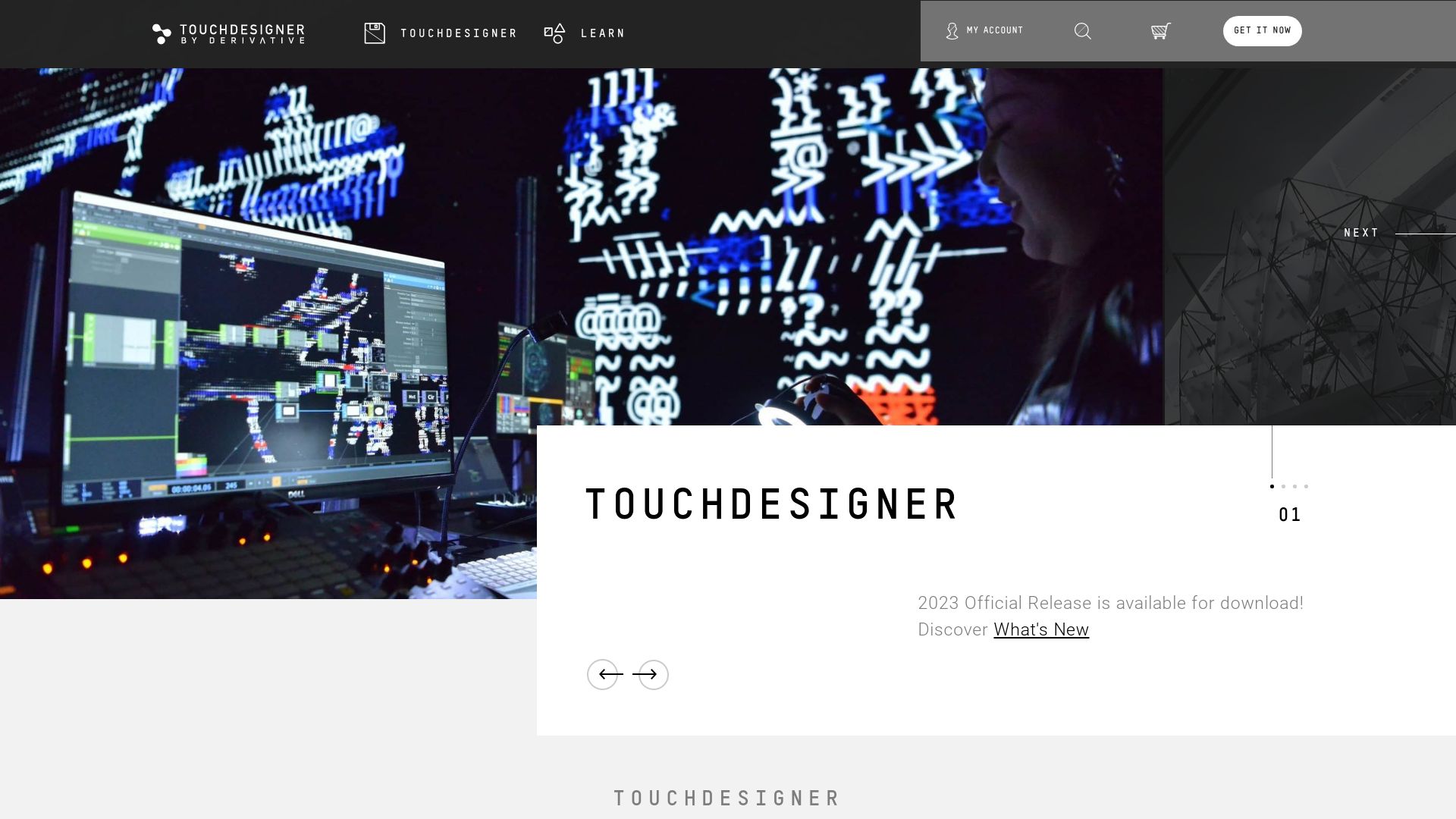
TouchDesigner is a formidable alternative to Houdini, highly celebrated for its node based visual programming capabilities that offer real-time interaction with multimedia content. Originating from Toronto-based company, Derivative, this platform finds its audience among diverse professionals like artists, programmers, designers and performers.
TouchDesigner Top Features
- Rendering and compositing of 2D and 3D productions.
- Work flow and scalable architecture for a smoother project management.
- Supports audio, video inputs and outputs including multi-display. Notably used for video mapping.
- 3D engine and tools ensuring high grade 3D modeling.
- Device and software interoperability for seamless integration.
- Offers scripting and programming for a greater degree of customisation.
| Category | Operators |
|---|---|
| Components | 3D objects, panels, ops |
| Texture | 2D image operations |
| Channel | Motion, audio, animation, control signals |
TouchDesigner Limitations
Despite a broad range of capabilities, TouchDesigner lacks in certain areas:
- Limited compatibility – TouchDesigner is compatible only with Windows and MacOS.
- Learning curve – Requires a certain level of programming knowledge making it less friendly for beginners.
TouchDesigner Pricing
While the pricing details for TouchDesigner are not explicitly mentioned, courses on this software are offered by Grayarea.org. The organization also provides scholarship diversity programs with no prior requirement of experience.
TouchDesigner Use Cases
Use case 1: Immersive Experiences, Interactive Installations
TouchDesigner is widely used to create immersive experiences and interactive installations due to its real-time interaction capabilities coupled with superior 3D tools.
Use case 2: Performance Tools for Lighting/Live Shows
Performers vouch for TouchDesigner as it offers comprehensive solutions for lighting/live shows – right from concept to curtain fall.
Use case 3: Generative Visuals for Artists
Artists find TouchDesigner particularly beneficial for creating generative visuals, thanks to its procedural geometry tools and scripting adaptability.
After Effects

Developed by the combined intellectual prowess of David Herbstman, David Simons, Daniel Wilk, David M. Cotter, and Russel Belfer, Adobe After Effects has been instrumental in revolutionizing the world of film, television, video, and web industries since it’s initial release in 1993 by the Company of Science and Art. Integrated with an array of Adobe Products like Photoshop, Illustrator, Premiere Pro, and more, After Effects has positioned itself as the industry-standard software for motion graphics.
After Effects Top Features
- Visual FX & Motion Graphics: Enables dynamic creation of motion graphics like animating logos, characters, allowing unique effects such as object removal from clips or creating elemental effects like rain and fire.
- 3D Space Navigation & Design: Allows ease of navigation and design in a 3D space, though it may not be the best for creating full 3D models or environments.
- Seamless Integrations: Works harmoniously with other Adobe products and also supports third-party integration to enhance workflow and functionality.
- Preset Offerings: A rich cache of presets from motion designers adds further to its resourcefulness.
| MediaType | Aplication |
| Films | Used for creating special effects, animating words, and adding dramatic elements like lighting effects and smoke trails. |
| TV | Significant use in post-production phase for layer stacking to create potent visual effects. |
| Web | Strong support for UI/UX mock-up animations, transforming images, and videos dynamically. |
After Effects Limitations
- Not suitable for creating full-fledged 3D environments and models.
- Better suited for post-production phase, hence may not be ideal for pre-production or production processes.
- Though integrated with other programs for 3D art, it is not a standalone 3D application.
After Effects Pricing
Available for individuals at $20.99/month, $35.99/month per license for teams, After Effects also offers a seven-day free trial. Moreover, it is included in Adobe’s Creative Cloud All Apps plan, which costs $54.99/month for individuals, $19.99/month for students and teachers, and an organized $84.99/month per license for teams.
After Effects Use Cases
Use case 1: Film Making
Notably utilized in iconic film titles like Star Trek: Into Darkness, After Effects is indispensable for special effects and dramatic enhancement. Ideal for layer stacking in the post-production phase.
Use case 2: Digital Marketing
Brands like Nike & CNN have leveraged After Effects for their campaigns, reflecting its strength in symbol animation, lighting effects, and transforming images.
Use case 3: Interactive Web Content
Google Home App stands testimony to After Effects’ dominant role in creating engaging and interactive web content by extending strong support for UI/UX mock-up animations.
Max MSP
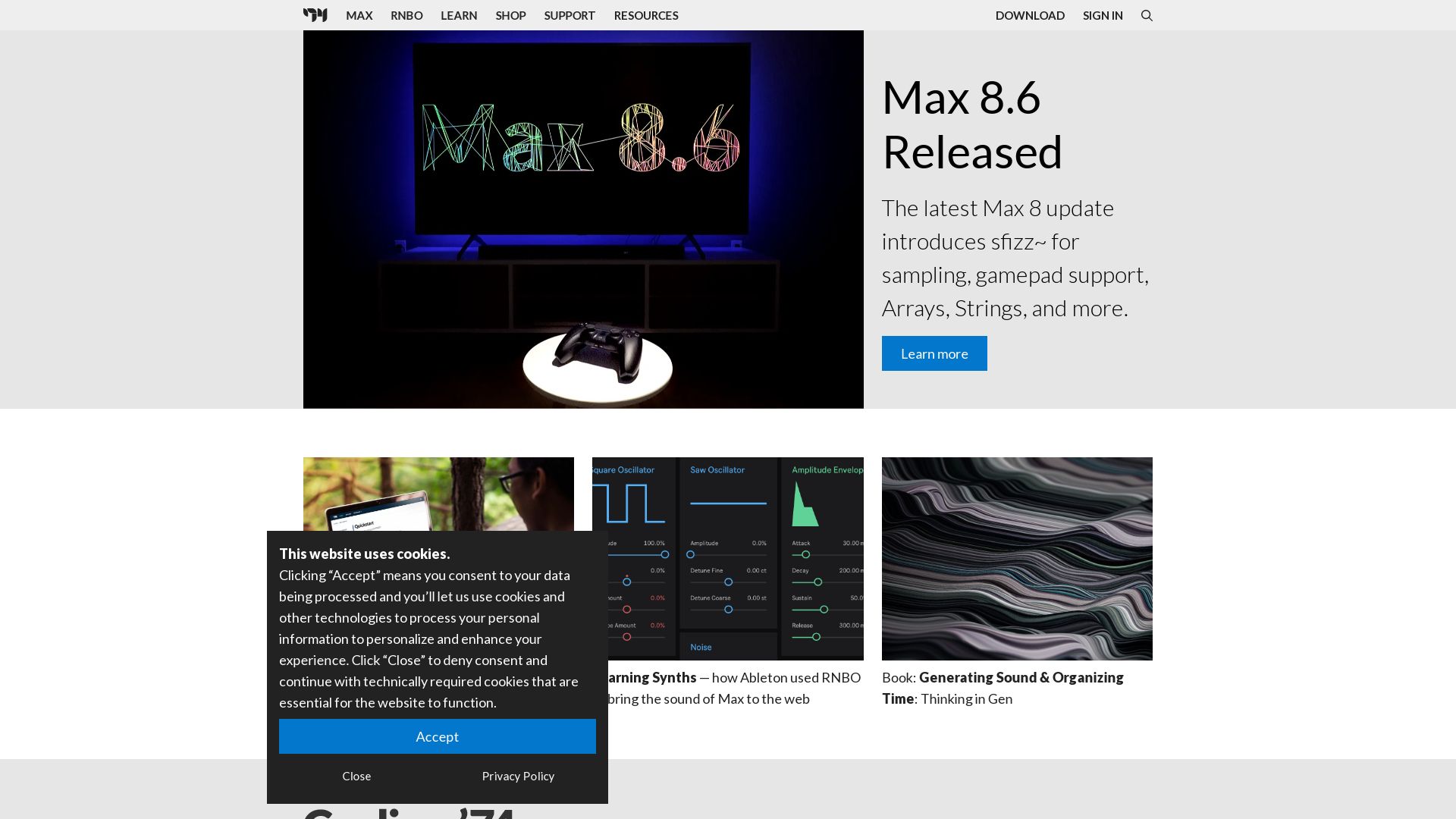
Developed by Cycling ’74, Max MSP is a visual programming language crafted with a focus on music and multimedia. Originating in the halls of Paris’ Institut de Recherche et Coordination Acoustique/Musique (IRCAM) in 1985, Max MSP has evolved, perfecting its capabilities for real-time digital audio signal manipulation and interactive computer music scores creation.
Max MSP Top Features
- Integration: Max MSP features an API for third-party enhancements.
- Compatibility: The program supports MIDI controllers, lending itself perfectly to laptop music/video performances.
- Detailed Audio Manipulation: Max MSP allows for complex audio data manipulation, timestretch, and pitch shifting.
- Versatility: Max users can design custom audio plugins for Ableton Live extension through MSP.
| Feature | Description |
|---|---|
| Responsive Design | Max MSP is designed to respond to mouse and keyboard controls and integrates with external devices through MIDI and other communication systems. |
| Work Friendly Interface | Max patching begins on a blank canvas, supporting creative exploration of complex ideas. |
| Extension Support | Max MSP supports extensions written in C, C++, Java, or JavaScript. |
Max MSP Limitations
- Learning Curve: The platform requires understanding of audio applications basics and digital audio programming environments.
- Dependent on External Hardware: Max MSP relies on digital audio devices designs for signal processing, which might not be ideal for users with limited access to external hardware.
Max MSP Pricing
Max MSP offers a 30-day trial period with full features accessibility. For more detailed information about pricing, please visit the official Cycling ’74 website.
Max MSP Use Cases
Use case 1: Custom Synthesizer Design
Max MSP shines in the creation and design of custom synthesizers, enhancing the creative toolset for music producers and sound designers alike.
Use case 2: Interactive Music Performance Software
The program’s real-time digital audio signal manipulation capabilities make it a powerful ally for creating interactive music performance software.
Use case 3: 3D Modeling and Video Extensions
Max MSP’s Jitter toolset introduces real-time video, OpenGL graphics and matrix processing capabilities. This makes it a crucial tool for 3D modelers and graphic designers.
Patrick Daugherty
Content writer @ Aircada. Merging AR expertise with a love for late-night gaming sessions.




